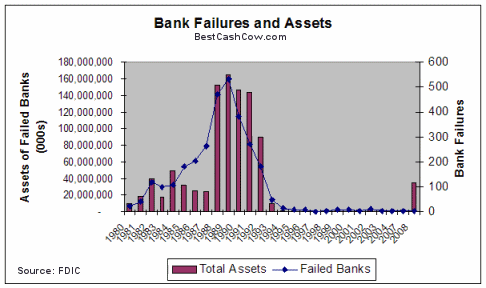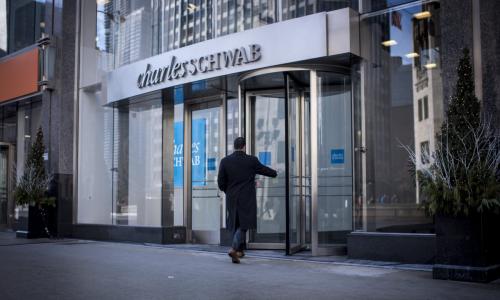I read an interesting post in the Blog Calculated Risk today. The article showed that the five banks that have failed in 2008 so far (including Indymac) were a blip compared to the 574 that failed at the height of the Savings and Loan crisis in 1989. At that time, the government was forced to bail out the banking industry to the tune of tens of billions of dollars.
Some of the comments on Calculated Risk pose an interesting question. Maybe there were more smaller banks in 1989 so that while there might have been more bank failures, they were relatively tiny from an asset perspective. And maybe one bank failure today is larger than hundreds of smaller bank failures back then. Determined to see if that was the case, I went to the FDIC website, downloaded the data on bank failures and their respective asset sizes, loaded it into Access, did a query or two, and..presto:

The bars show the combined assets of the failed banks for each year while the line shows the number of failed banks. As you can see, the number of failed banks is tiny today compred to ten years ago and so were their respective assets - until Indymac. $32 billion of this year's $34 billion in failed assets were attributable to Indymac.
Let's look at this another way. The chart below shows the average assets for bank failures by year.

The largest bank failure was in 1984 when Continental Illinois National Bank and Trust Company, a $40 billion dollar bank collapsed. As the chart shows, other bank failures during that time kept the average relatively flat. Another intersting, fact, the failure of Continential Illinois was considered to be a forerunner of the S&L mess.
To all of this, add the fact that there are 50% fewer banks today than there were 10 years ago.
So, here's the real question. Is the average so high because small banks have done a better job managing their balance sheets and asset risks and remained solvent? Or is Indymac just an aberration and no more bank failures will be coming? Or, is Indymac, like Continental Illinois, a leading indicator of what will be fewer but much larger future bank failures?






Comments
Sam Cass
September 27, 2008
With WaMu gone the fewer but larger bank failures seems to be the winner. But of course, we will see a wave of more banks failing so we'll see what happens.
Is this review helpful? Yes:0 / No: 0
Ronald M. Harriman
April 06, 2009
if you would recall the failure of contiental was due to loan defaults by Mexico and Brazil. the savings and loans crisis was precipitated by the FDIC's move on the funds of the FSLIC wherein the notified the Savings and loans that they would have to double their reserve ration from 1.5 pts to 3 pts. this immediately caused nearly every savings and loan in the U. S. to be unballanced. the Savings and Loan Crisis was caused by the Feds.
Is this review helpful? Yes:0 / No: 0
Sarah in South Jersey
May 06, 2009
Are there as many small banks today as there were in the 1980's? or have they been gobbled up and oligopolized?
I personally am a BoA customer due to four acquisitions that culminated in BoA since 1993.
opened an account with First Union Bank, up the street from home, became Bank South, became Nationsbank and now BoA.
Also, when BoA went into NY state I see them situated in locations that used to be smaller banks.
So when a big bank fails today it should equal at least 4 times as many banks in the 80's?
Is this review helpful? Yes:0 / No: 0
Donald Glassman
August 03, 2009
I remember CD and mortgage rates at about 18%, around 1980 when Continental IL failed, and taken over by Bank of America.
Can you please verify that for me?
Is this review helpful? Yes:0 / No: 0
Donald Glassman
August 03, 2009
I can be reached via email :
duckman1@earthlink.net
I hope some old timer can respond regarding Continental IL. Bank's rates on CD's and mortgages of about 18%
Thanks for response
Donnie G
Is this review helpful? Yes:0 / No: 0
Add your Comment
or use your BestCashCow account